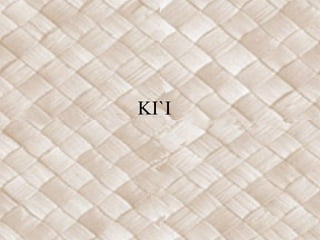
Learn About Traditional Hawaiian Carvings and Their Meanings
- 1. KI`I
- 2. KI`I • n. Image, statue, picture, photograph, drawing, diagram, illustration, likeness, cartoon, idol, doll, petroglyph;
- 3. KI`I LĀ `AU
- 4. `ŌHI`A LEHUA
- 5. CARVING KI`I
- 6. AKUA KĀ `AI • Kā`ai – Sash, belt, girdle of any kind; protective cloth wrapped around an object; to bind, tie around, encircle, gird on; to put on, as armor or a mourning garment.
- 7. KAUILA
- 8. KOU
- 9. AKUA HULU
- 10. `IE`IE
- 11. OLONĀ
- 12. If you have any questions, please ask them on the Discussion Board. Mahalo!
Editor's Notes
- To the kanaka maoli, the gods were everywhere through kinolau and in ki`i or sacred images Traditional sacred sculptures in heiau Smaller, secondary images used in temples, on the family altar in the hale mua (men’s eating house) and other locations So few ki`i have survived the wave of destruction of temples and images that came with the ending of `ai kapu that we will learn a little more about in an upcoming unit
- Ki`i are sacred images or wooden statues of the Hawaiian gods. The large ki`i were in heiau, but sadly most of the ki`i were destroyed when the kapu system was abolished in 1819. The bent knee position demonstrates a warrior going into battle. The bent knee position symbolizes balance, enhancing the ability to shift weight quickly when throwing or dodging a spear. Bent knees also demonstrated being prepared and grounded This ki`i lã`au is a specific ceremonial object, especially created by the kaua ali`i to house an `aumakua who excelled in warfare, "[t]his ki`i lã`au is associated with a war god or an ancestral deity who excelled in warfare... This god would be personal to the ali`i, usually an ancestor with exceptional warfare skills. " This ki`i lã`au was devoted to a religious ceremony or ritual, the ki`i lã`au was carved in preparation for warfare, at the time the war canoe was built. An `aumakua was called upon to inhabit the ki`i lã`au. Once the god took residence, the ki`i lã`au was ceremonially consecrated by the kaua ali`i through prayer and the feeding of fish, awa, and other nourishment. The ki`i lã`au was then lashed to the war canoe. Prior to battle, warriors consecrated their weapons, including their war canoe, to seek lokahi (balance) with their gods, clearing the way for success in battle." Moreover, the kaua ali`i who possessed the ki`i lã`au would have been considered a traditional religious leader
- Most of the large images were carved from wood of the `ōhi`a lehua – regarded as a kinolau of the gods Kāne and Kū The reddish color of the freshly cut wood may have been considered appropriate for figures associated with sacrifices The wood tends to crack as it dries Exposure to rain and sun has the effect of bleaching the wood, turning it gray as seen in the ki`i at Hale o Keawe at Pu`uhonua o Hōnaunau in Kona
- Most made from `ōhi`a lehua, but other woods were used – such as kauila or kou The lower part of many akua kā`ai is a pointed stake to be thrust into the ground, making them usable almost anywhere. Though they probably occupied set locations at most times and were removed only to be taken into battle or on other important occasions They were carried directly on one’s person in a kapa sash or kā`ai or in a separate piece of kapa also known as kā`ai
- Kauila is a medium-tree, with thin oblong leaves which are bright green on both sides. This is a rare native tree found only in Hawaii and Oahu. The bark of the tree is light brown, with a very hard, reddish wood that sinks in water. The wood was formerly valued by the early Hawaiians for spears and tapa beaters. This is one of the hardest, densest native wood that replaced metals in the economy of the ancient Hawaiians.
- A canoe plant Orange flowers that are scentless
- Feathered gods such as Kūkā`ilimoku, Kamehameha’s feathered war god Base made of `ie`ie Feathers fastened on netting made from olonā in the same manner as feather capes were Eyes were made of pearl shell Dog teeth or shark teeth were used It was cared for by a kahu, or caretaker who was a member of the ali`i class As a kinolau of Kū, the akua hulu’s primary roles were to serve as a protector and guide
- Ie`ie (Freycinetia arborea) `Ie`ie is the plant that winds its way up the `ohi`a lehua. Could be a kinolau of Ku as well as Lono, the husband of Laka. It also represents Lauka`ie`ie, a demigoddess, and skill and striving knowledge for the haumana of hula. Roots braided to serve as cordage
- Canoe plant Male and female flowers occur on separate plants, with the female plants producing small, hard seeds Accounts tell us that olonā was cultivated. In fact, was the only non-food plant that was cultivated because of its great value The olonā requires a great deal of moisture in the soil and in the air and as such was typically found in rainy areas – parts of the mountains that are always mossy from water and rain According to Kamakau, the plants were encouraged to grow densely, tall and straight After a year when the leaves turned yellow, the plants were harvested Lightweight, yet one of the strongest cordages made/ Its excellence made olonā cordage a highly valued item